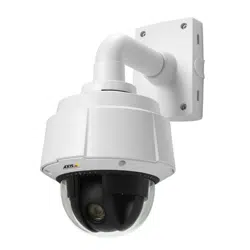Loading ...
Loading ...
Loading ...

41
AXIS Q6032-E - Troubleshooting
Symptoms, possible causes and remedial actions
Problems setting the IP address
When using ARP/Ping Try the installation again. The IP address must be
set within two minutes after power has been
applied to the camera. Ensure the Ping length is set to 408. See the Installation Guide.
The camera is locat
ed on a different
subnet
If the IP address intended for the camera and the IP address of your computer are located on dif-
ferent subnets, you will not be able to set the IP address. Contact your network administrator to
obt
ain an appropriate IP address.
The IP address is being used by another
device
Disconnect the camera from the network. Run th
e Ping command (in a Command/DOS window,
type ping and the IP address of the unit).
If you receive: Reply from <IP addr
ess>: bytes = 32; time = 10 ms..... - this means that the IP
address may already be in use by another device on your network. You must obtain a new IP
address and reinstall the unit.
If you receive: Re
quest timed out - this means that the IP address is available for use with your
camera. In this case, check all cabling and reinstall the unit.
The camera cannot be accessed from
a web browser
Cannot log in When HTTPS is enabled, ensure that t
he correct protocol (HTTPS or HTTPS) is used when attempt-
ing to log in. You may need to manually type h
ttp or https in the browser’s address field.
The IP address has been changed by
DH
CP
If the camera and client are on the same network. Run AXIS IP Utility to locate the camera. Iden-
tify the camera using its model or serial number.
Alternatively:
1) Move the camera to an isolated network or to
one with no DHCP or BOOTP server. Set the IP
address again, using AXIS IP Utility or the ARP Ping command.
2) Access the unit and disable BOOTP and DHCP in th
e TCP/IP settings. Return the unit to the
main network. The unit now has a fixed IP address that will not change.
3) As an alternative to 2), if dynamic IP addres
s via DHCP or BOOTP is required, select the
required service and then configure IP address change notification from the network settings.
Return the unit to the main network. The unit will now have a dynamic IP address, but will notify
you if the address changes.
Other networking problems Test the network cable by connecting it to anoth
er network device, then Ping that device from
your workstation. See instructions above.
Camera is accessible locally, but not externally
Broadband router configuration To configure your broadband router to allow incoming data traffic to the camera, enable the
NAT-traversal feature which will attempt to automatically configure the router to allow access
to the camera.
This is enabled from S
etup > System Options > Network > TCP/IP Advanced.
Note that the router must support UPnP
TM
.
Firewall protection Check the Internet firewall with your system administrator.
Default routers required Check if you need to configure the default router settings.
Problems with the H.264 format
No H.264 displayed in the client Check that the correct network interface is select
ed in the AMC control panel (streaming tab).
Check that the relevant H.264 connection methods ar
e enabled in the AMC control panel applet
(streaming tab).
In the AMC Control Panel, select the H.264 tab and
click the button Set to default H.264
decoder.
No multicast H.264 displayed in the
cli
ent.
Check with your network administrator that the multicast addresses used by the camera are
valid for your network.
Check with your network administrator to see
if there is a firewall preventing viewing.
Multicast H.264 only accessible by
local clients.
Check if your router supports multicasting, or if the router settings between the client and the
server need to be configured. The TTL (Time To Live) value may need to be increased.
Poor rendering of H.264 images. Color depth set incorrectly on clients. Set to 16-bit or 32-bit color.
In text overlays are blurred, or if there are other rendering
problems, you may need to enable
Advanced Video Rendering from the H.264 tab in the AMC Control Panel.
Ensure that your graphics card is using the latest device
driver. The latest drivers can usually be
downloaded from the manufacturer's web site.
Color saturation is different in H.264
and Motion
JPEG
Modify the settings for your graphics adapter. Please see the adapter's documentation for more
information.
Loading ...
Loading ...
Loading ...
